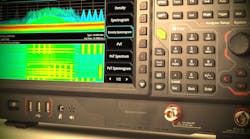In Need of a Real-Time Spectrum Analyzer? Set Your Eyes on This New Solution
Download this article as a .PDF
The real-time spectrum analyzer (RTSA) is an important instrument today. But what is an RTSA? And how is it different from a traditional swept-tuned spectrum analyzer? Here, we’ll discuss some basic differences before talking about a brand-new RTSA now on the market.
So what are the fundamental differences between an RTSA and a traditional swept-tuned spectrum analyzer? Michael Rizzo, general manager at RIGOL Technologies explains: “The differences between a swept-tuned spectrum analyzer and a RTSA are fairly fundamental. A swept-tuned spectrum analyzer basically acquires power measurements across a span—left to right, low to high.
“Since they sweep from left to right, they add a single data point at each measurement step and build an image of what’s happening in the spectrum over time,” he continues. “That’s the way that analyzers have been working for many years, and it’s an essential part of an RF toolkit.”
This new RTSA is available either as a 3.2-GHz or 6.5-GHz model.
However, the current landscape often requires more than what these traditional analyzers can offer. “In today’s world,” Rizzo adds, “multiple signals are sitting on top of each other in a crowded band and frequencies and pulses are moving really fast (i.e., frequency hopping, amplitude shift technology, etc.). That transient nature of these signals makes them real hard to see with a swept-tuned spectrum analyzer.”
Let’s now talk about what RTSAs can do. “What RTSAs do is capture data across a fixed span in time,” continues Rizzo. “With that data, they then use an FFT process to display the power across the entire span. What happens is that each of those snapshots in time across the real-time bandwidth allows frequency components to be displayed from the same captured data. Since that is happening, you don’t miss those transient signals—there is no sweeping. Like a photograph, you catch everything that is happening in that span.”
He further adds: “By speeding up the FFTs and overlaying them so that they don’t happen sequentially, but rather in a staggered basis, you obtain a gapless view of that time and you don’t miss anything between the FFT transactions. Since you’re sampling in time, you can also look at changes in frequency over time. This brings a whole new dimension of visualization and debugging to the spectrum analyzer world.”
With all of that being said, let’s discuss RIGOL’s new RSA5000 RTSA (see photo). By definition, real-time bandwidth is the subset of the instrument’s frequency range in which you are taking FFTs, or snapshots. The RSA5000 is equipped with 25-MHz real-time bandwidth and customers can upgrade that to 40 MHz by purchasing the 40-MHz upgrade option.
Probability of intercept (POI) is another important parameter, as it describes the shortest duration pulse that the instrument can capture and display for an accurate power measurement. The RSA5000 takes 146,484 FFTs per second, achieving a POI of 7.45 µs.
The targeted applications for the RSA5000 include spectrum monitoring, advanced RF measurements, RF device characterization, and EMI pre-compliance.
For more information, visit the company’s microsite.


